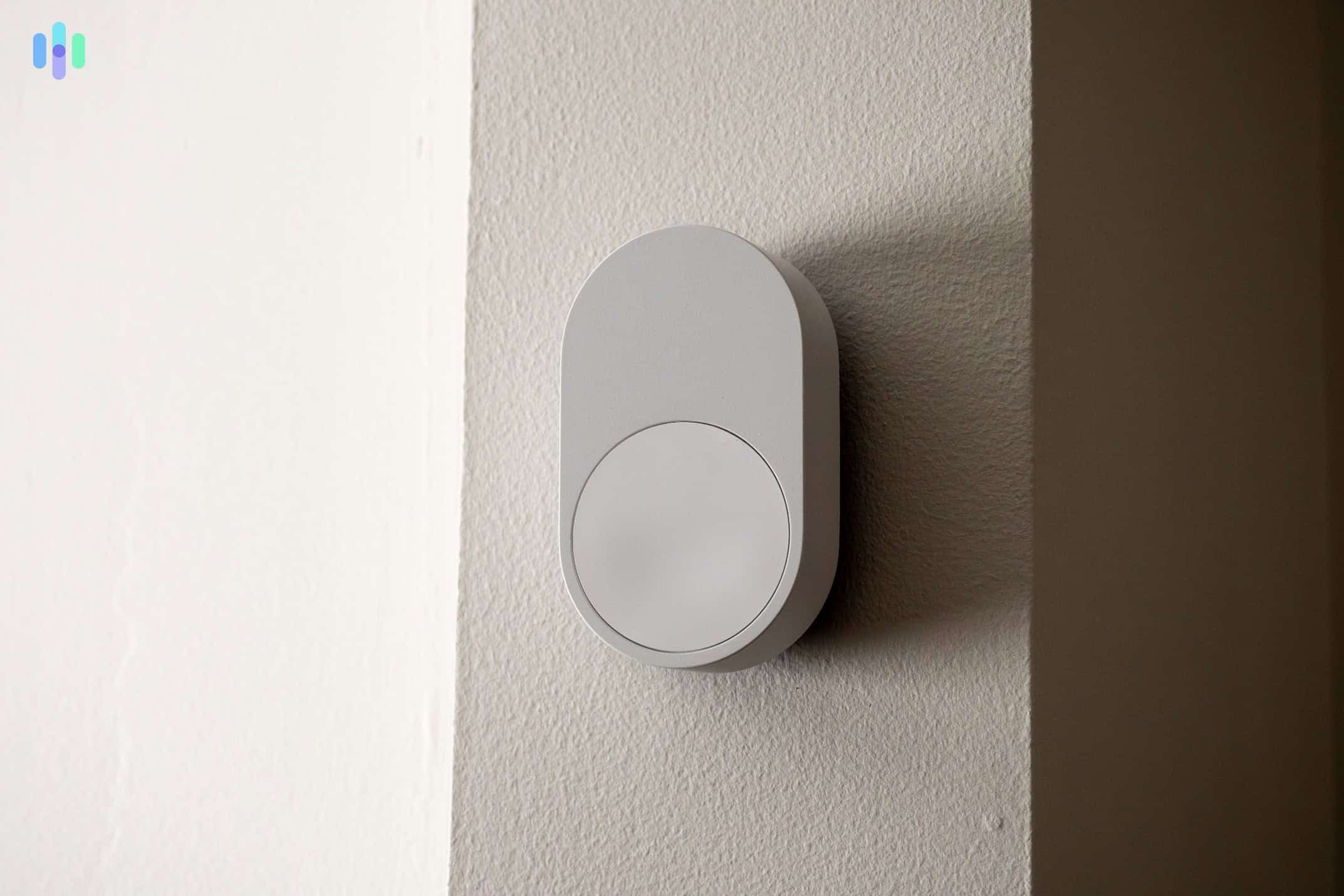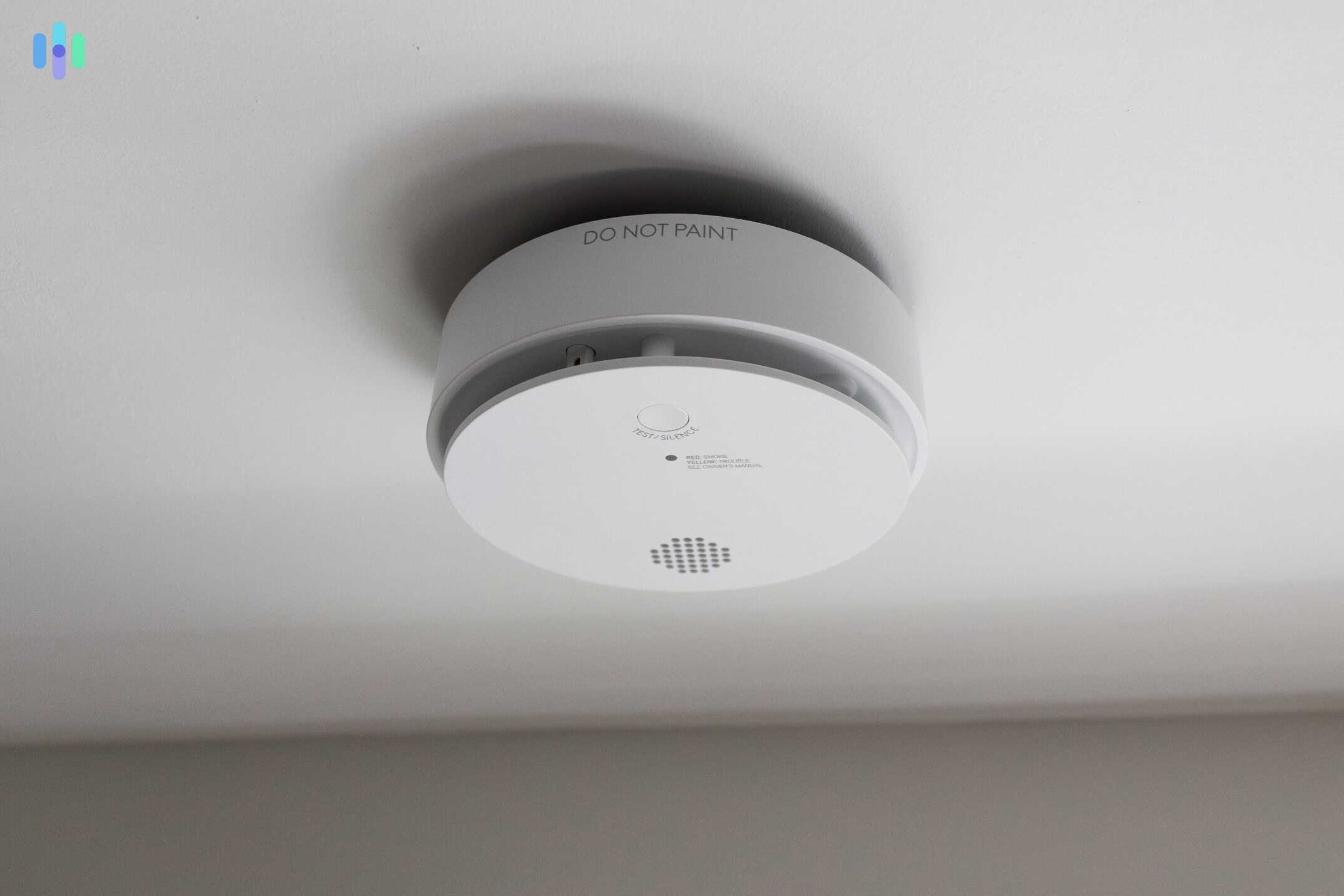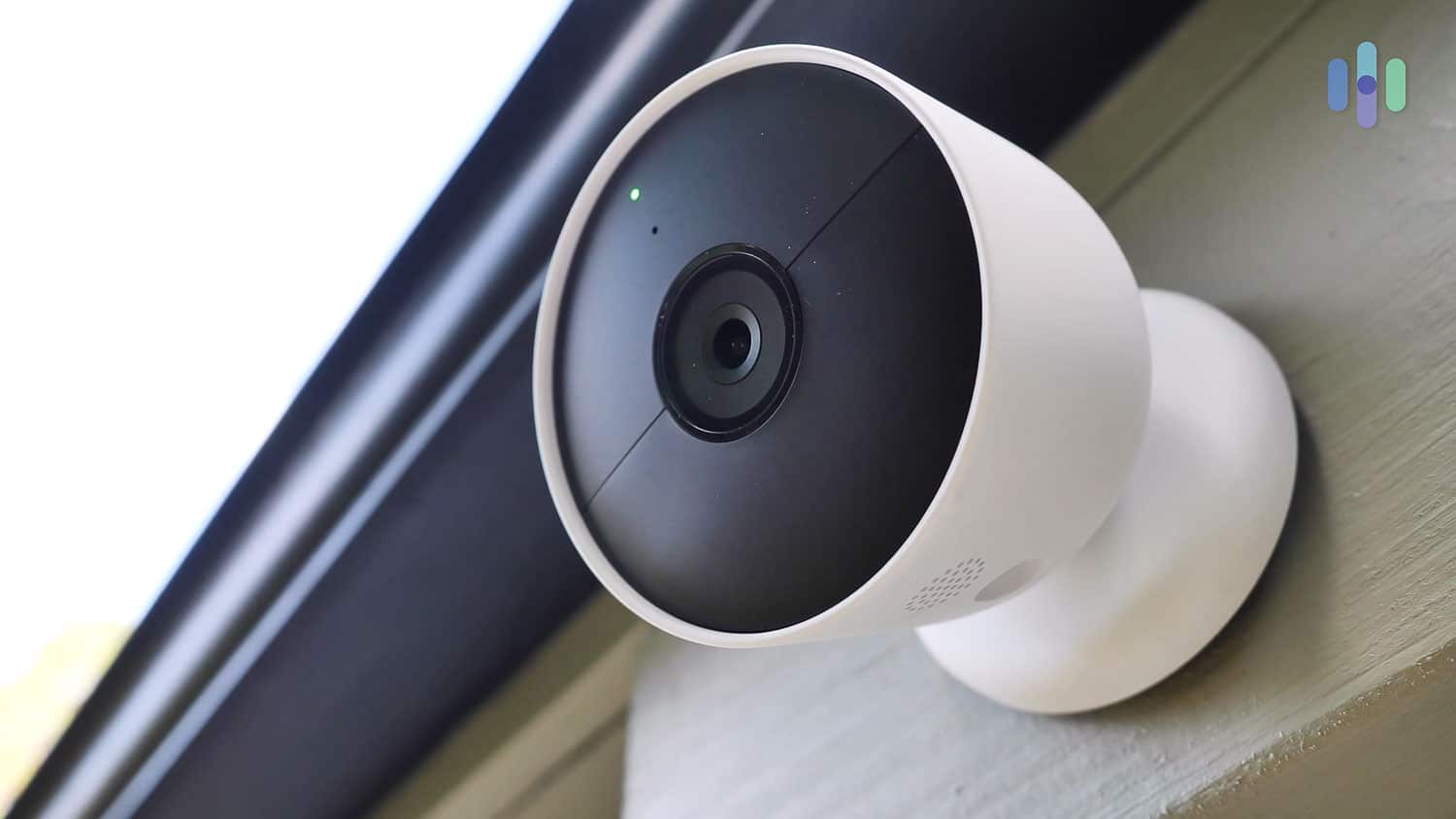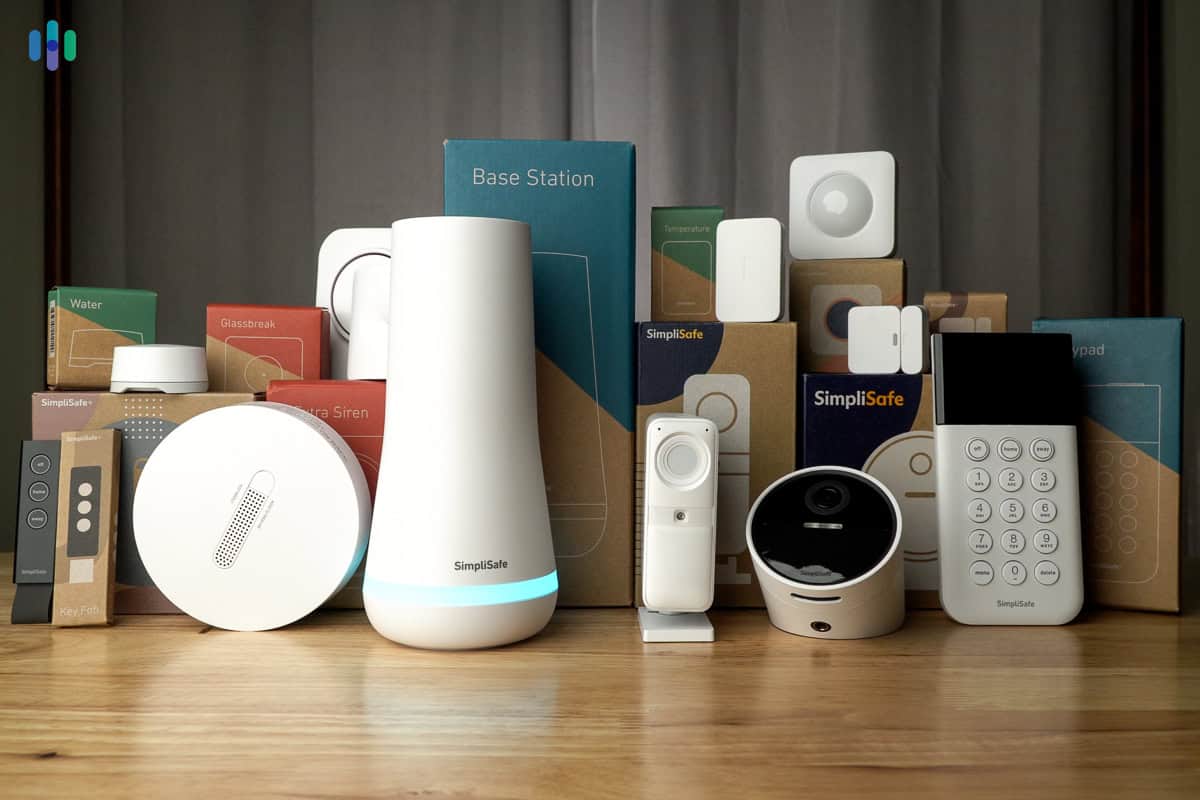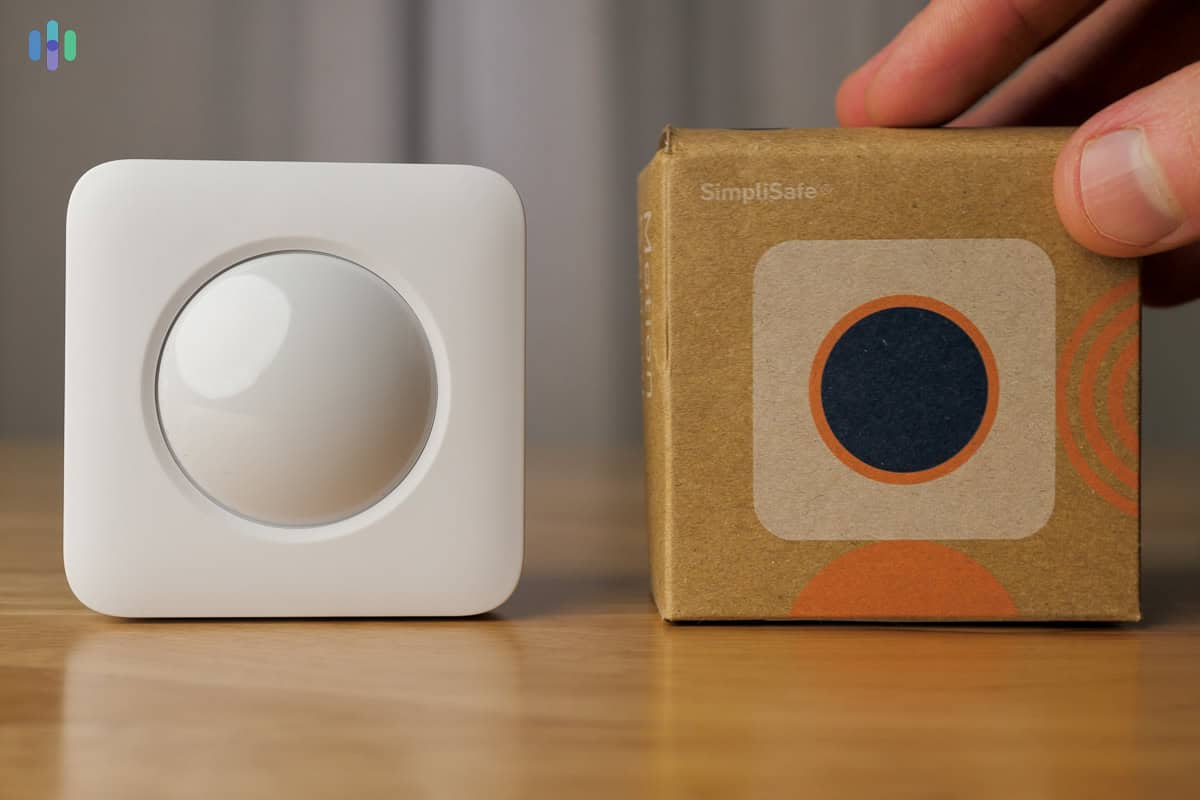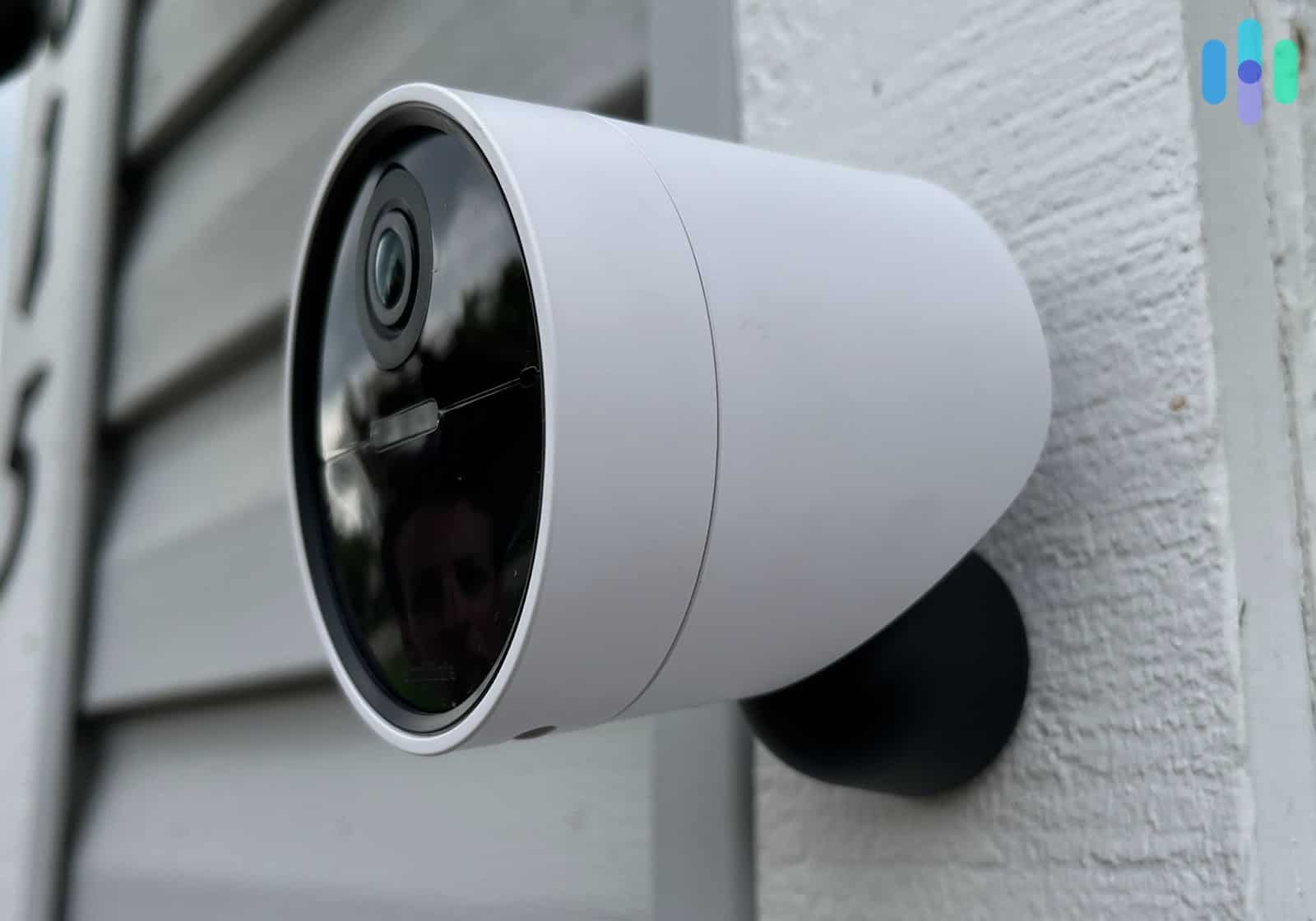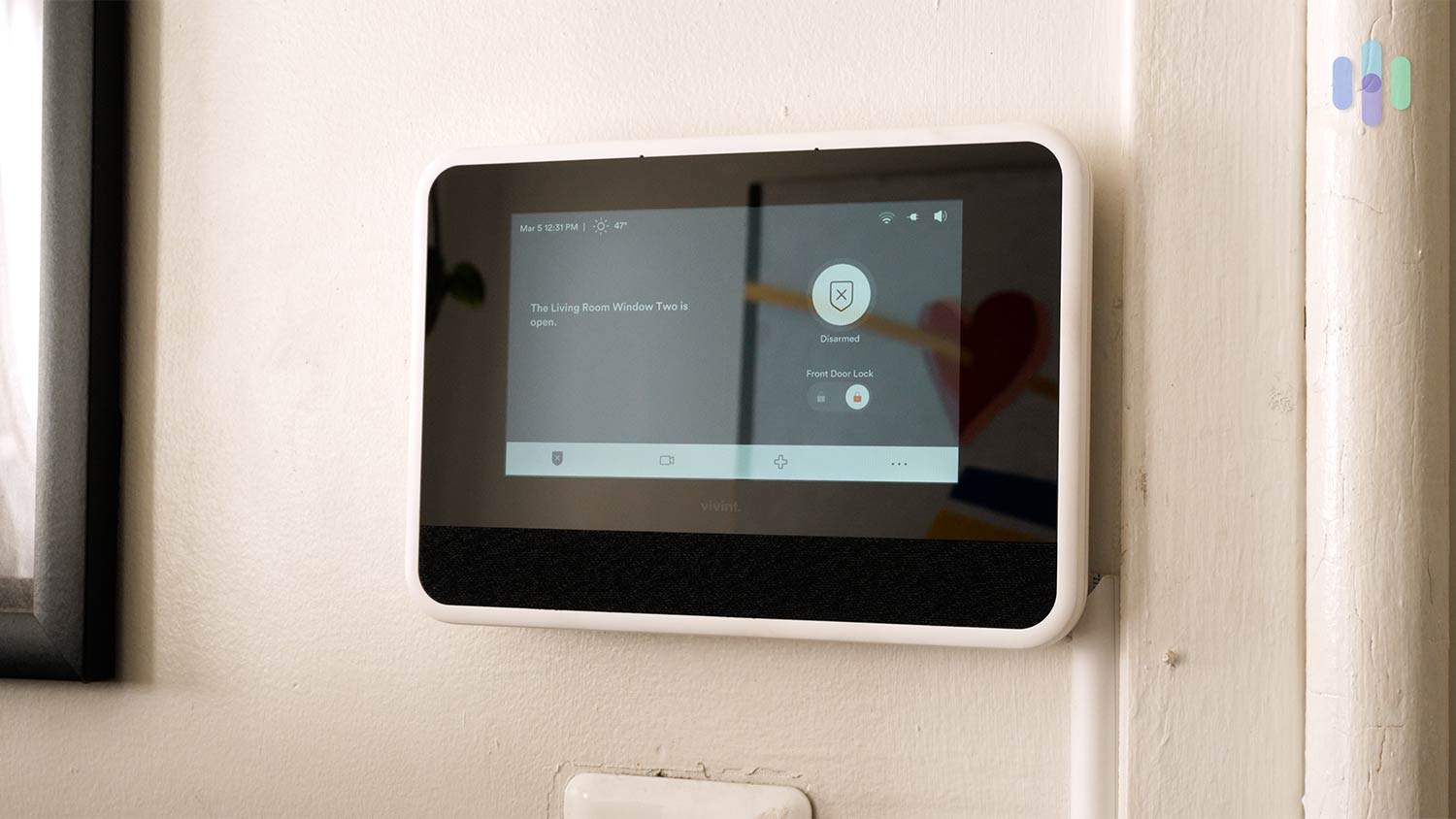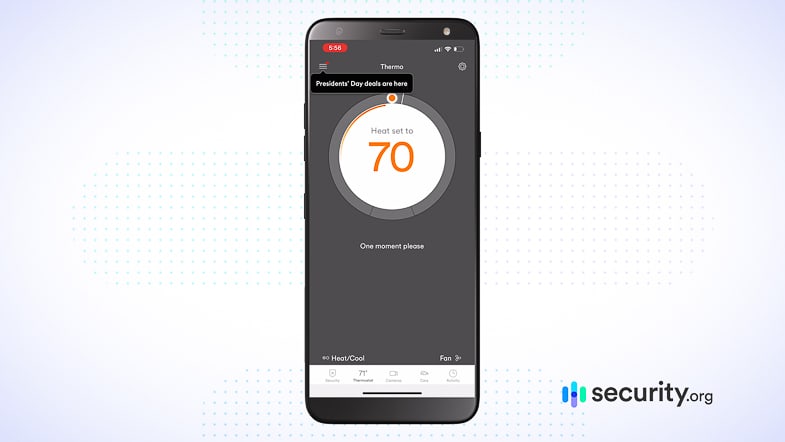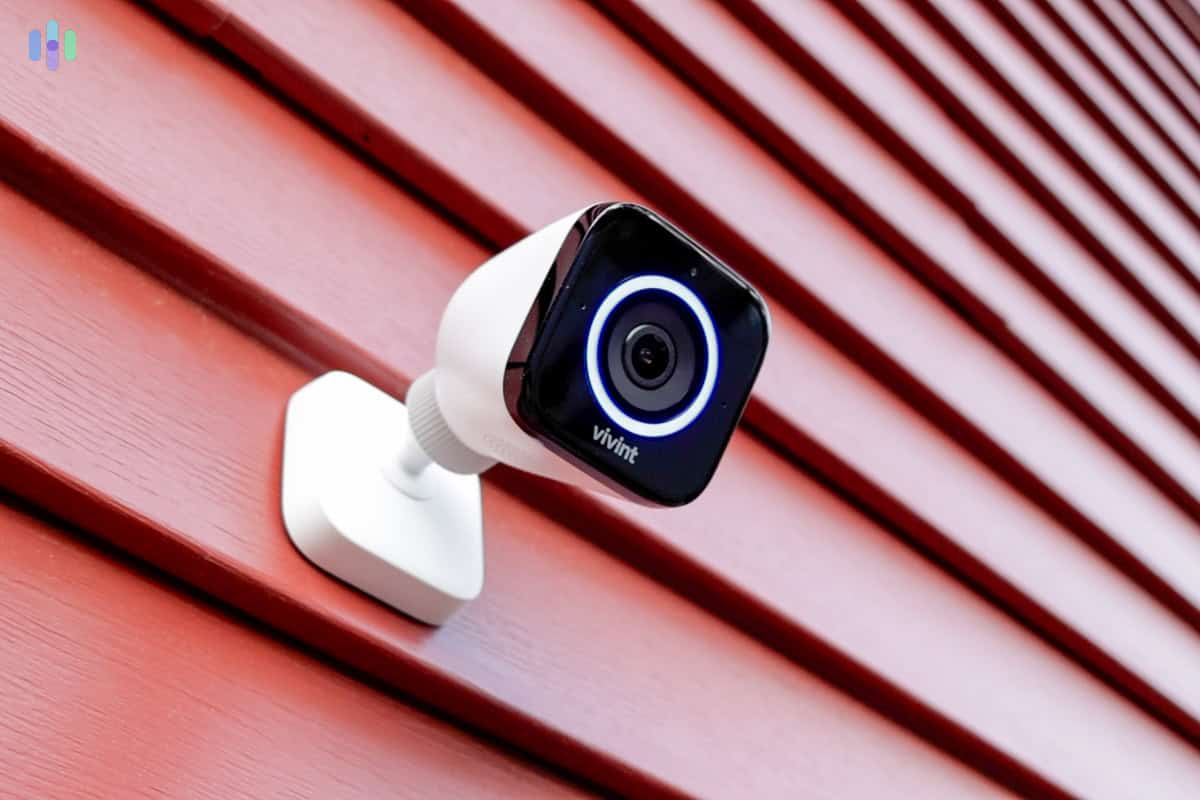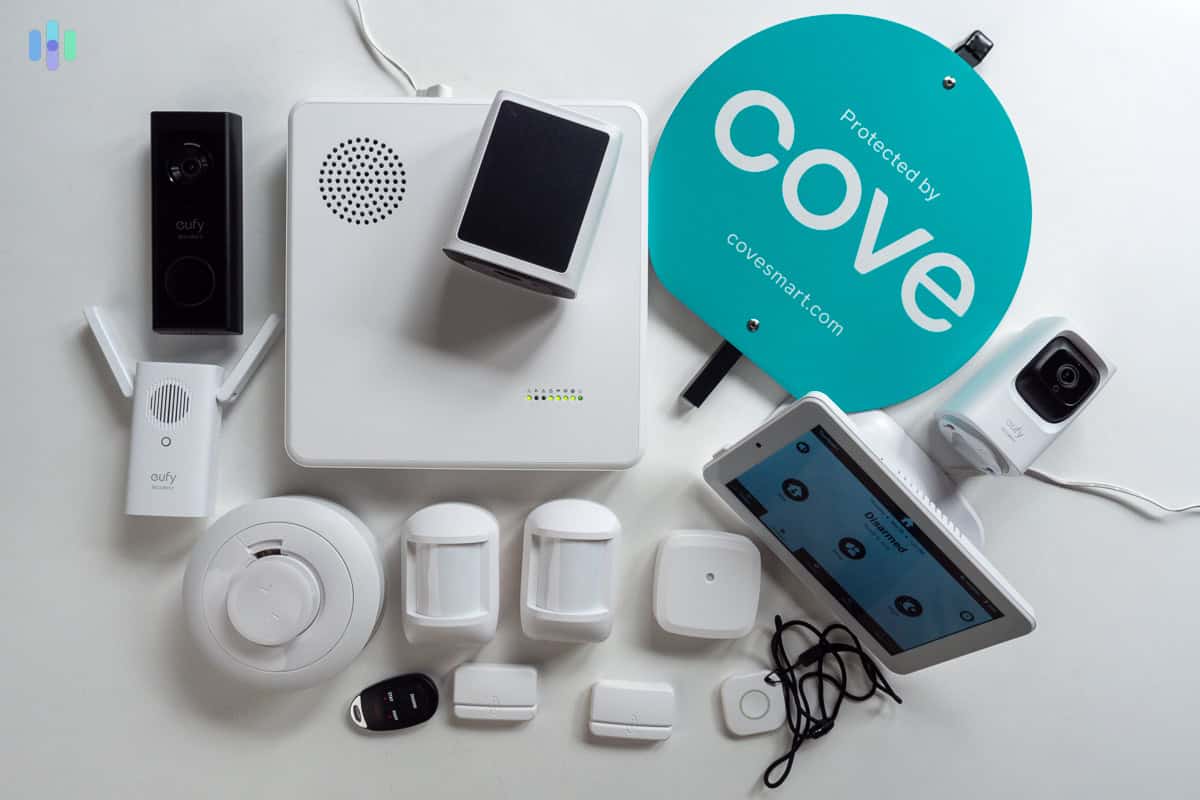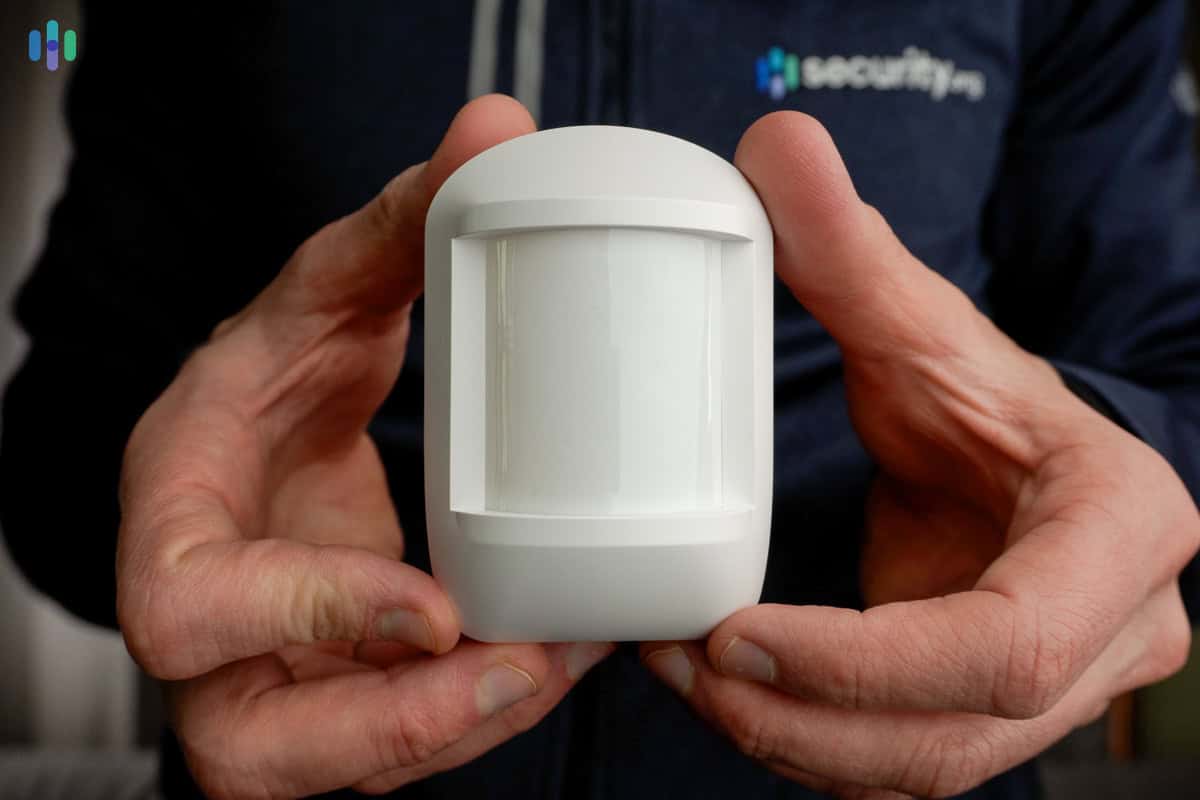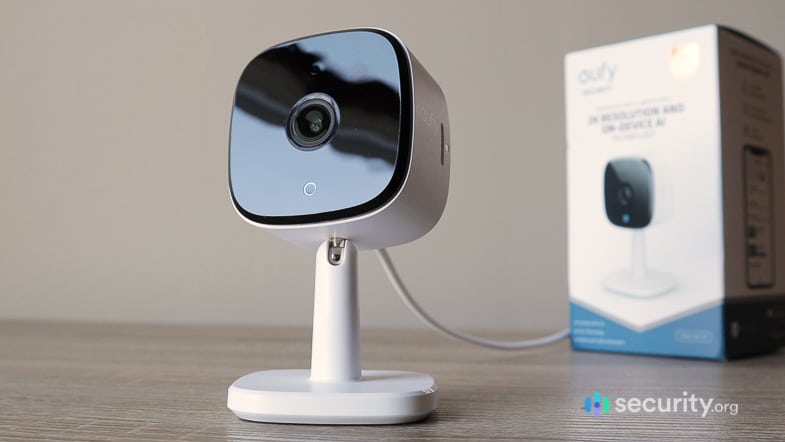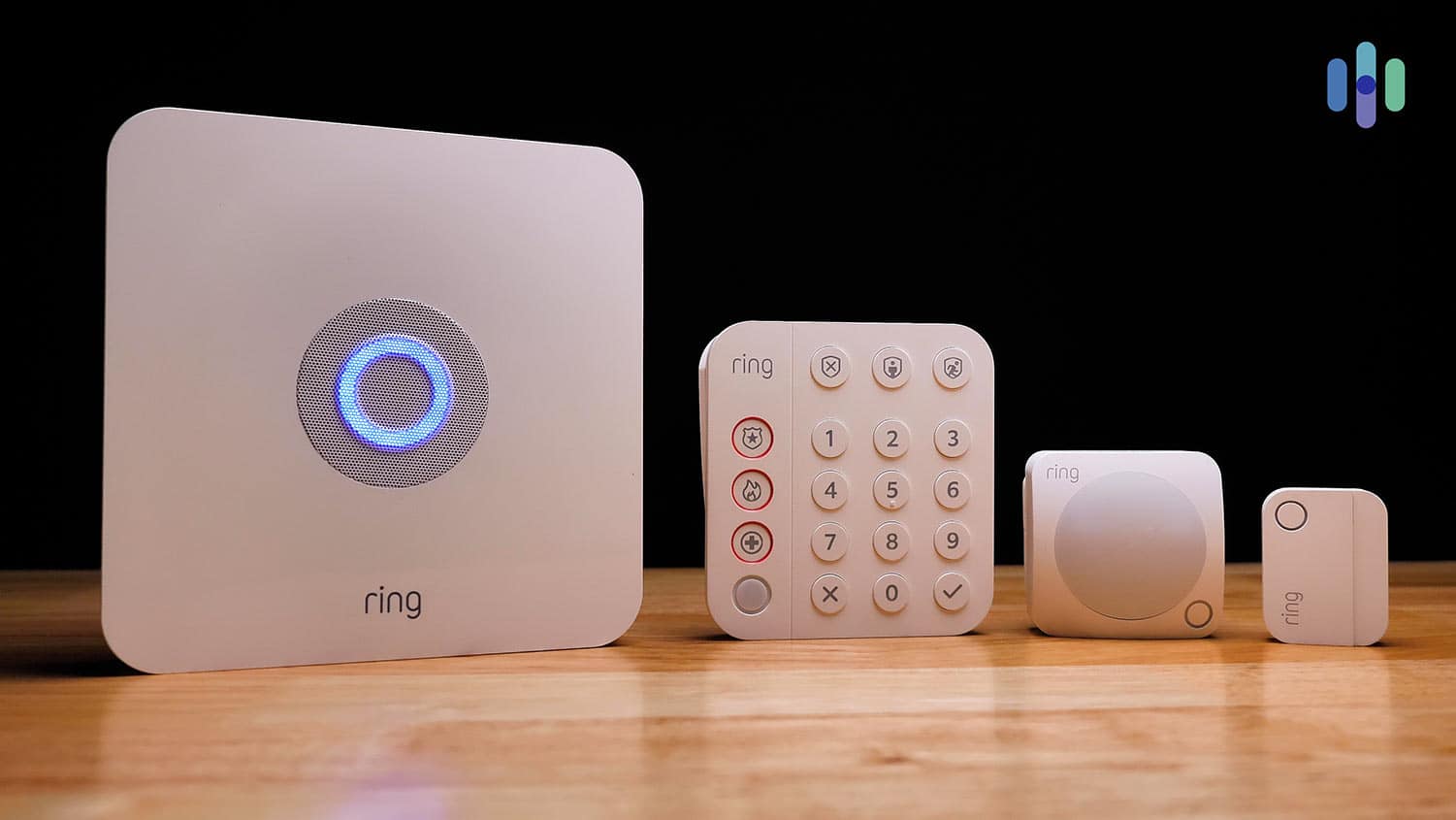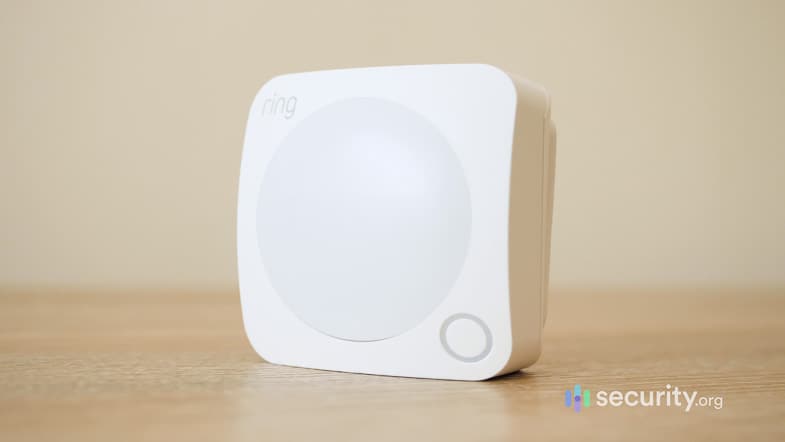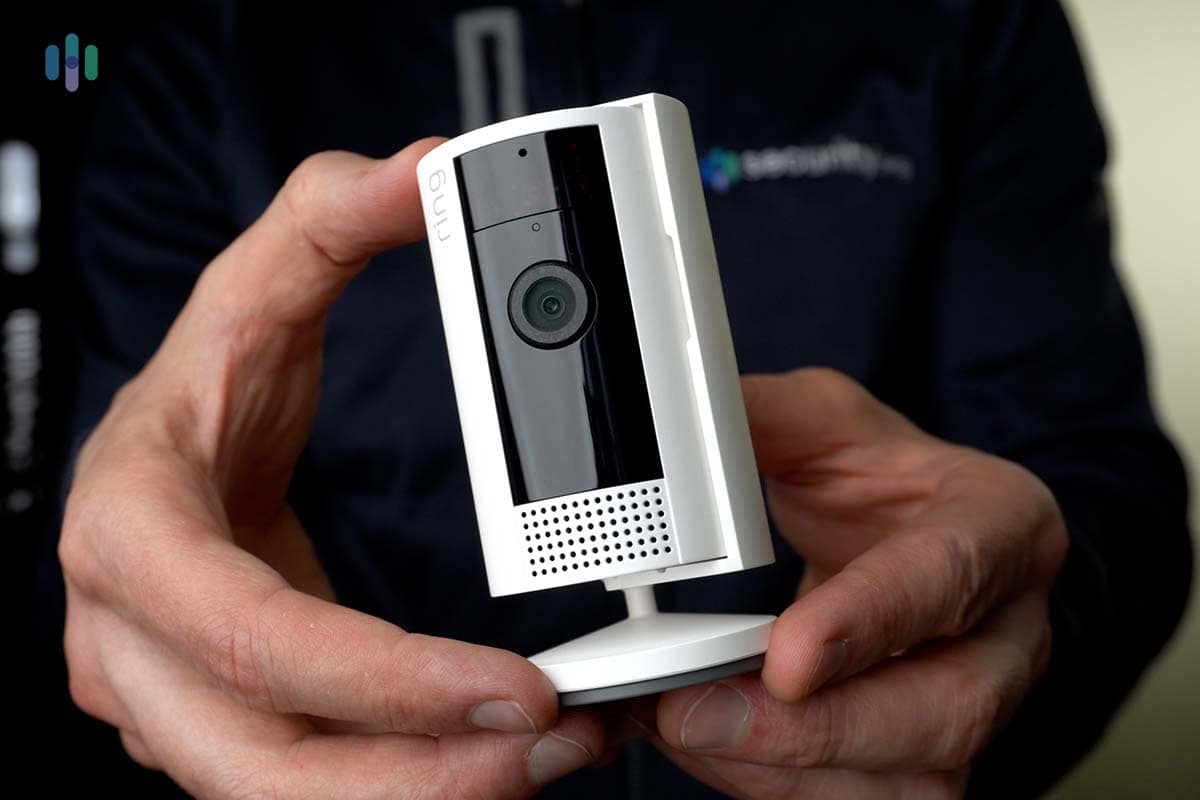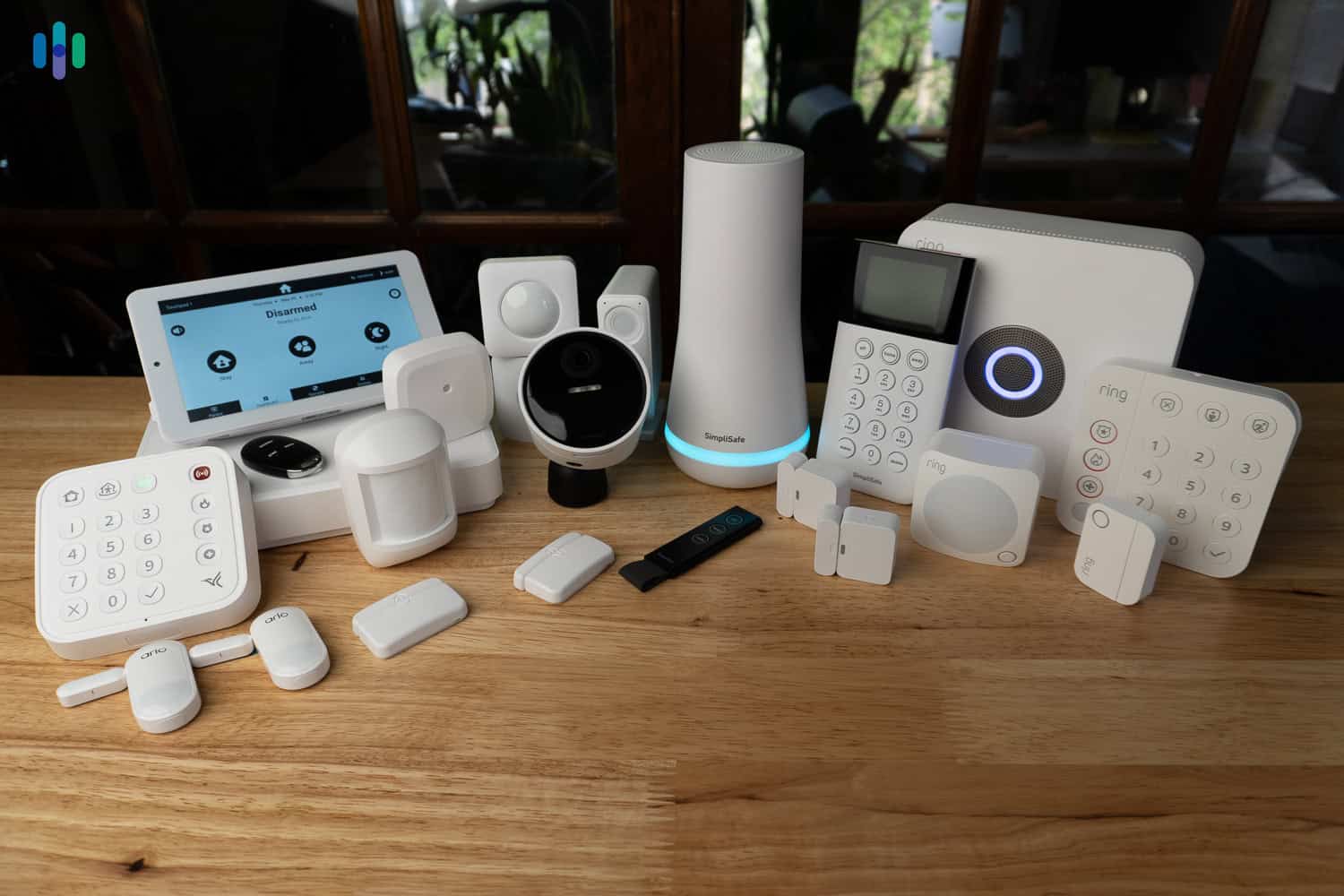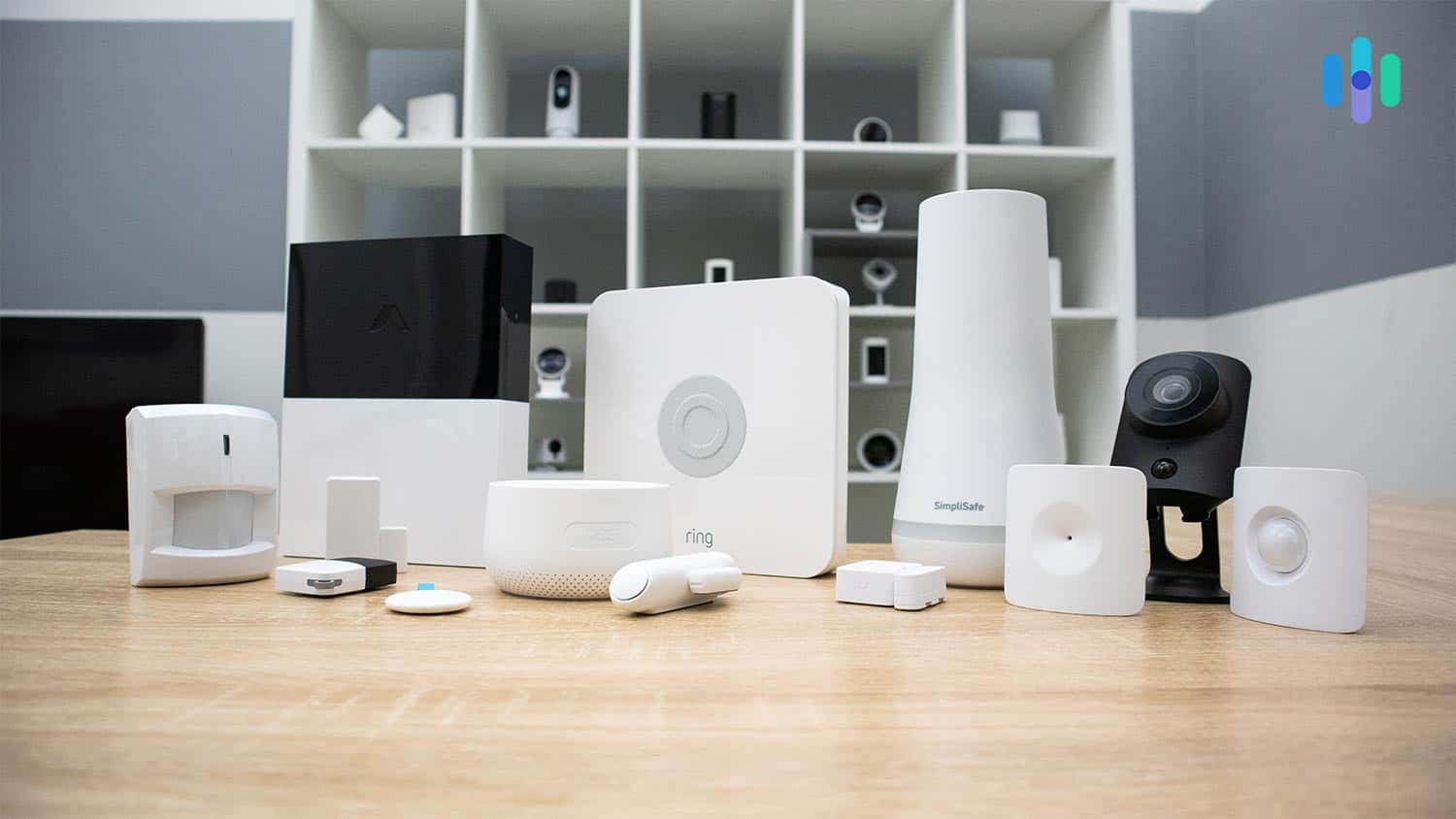The Best Home Security Systems for Pet Owners in 2025
We ranked ADT number one for its professional installation, high-quality equipment with pet detection, and reliable 24/7 monitoring.
- Professional installers can adjust sensors to ignore your pet, for fewer false alarms
- Professional monitoring helps keep your pet safe around the clock, even when you’re away
- Available smart plugs let you turn on your TV remotely to keep your dog or cat company while you’re at work
- SimpliSafe motion sensors ignore pets that weigh less than 60 pounds
- Video verification system means pets are less likely to trigger alarms
- Use the SimpliSafe app to remotely monitor your home during the day
- Set smart locks to allow your pet sitters easy access to your home when you’re on vacation
- Fine tune motion sensors to keep large dogs from setting off alarms
- Keep the temperature perfect for your pet with Vivint’s environmental controls
We love our pets. But as pet-loving security experts, we have to admit that having four-legged companions makes choosing a security system a lot more complicated. Pick the wrong system, and you could end up with false alarms every time Fido runs through the living room.
You need a system that works with pets – and keeps them safe and comfortable. It’s a big responsibility, but as fellow pet parents, we’re here to help.
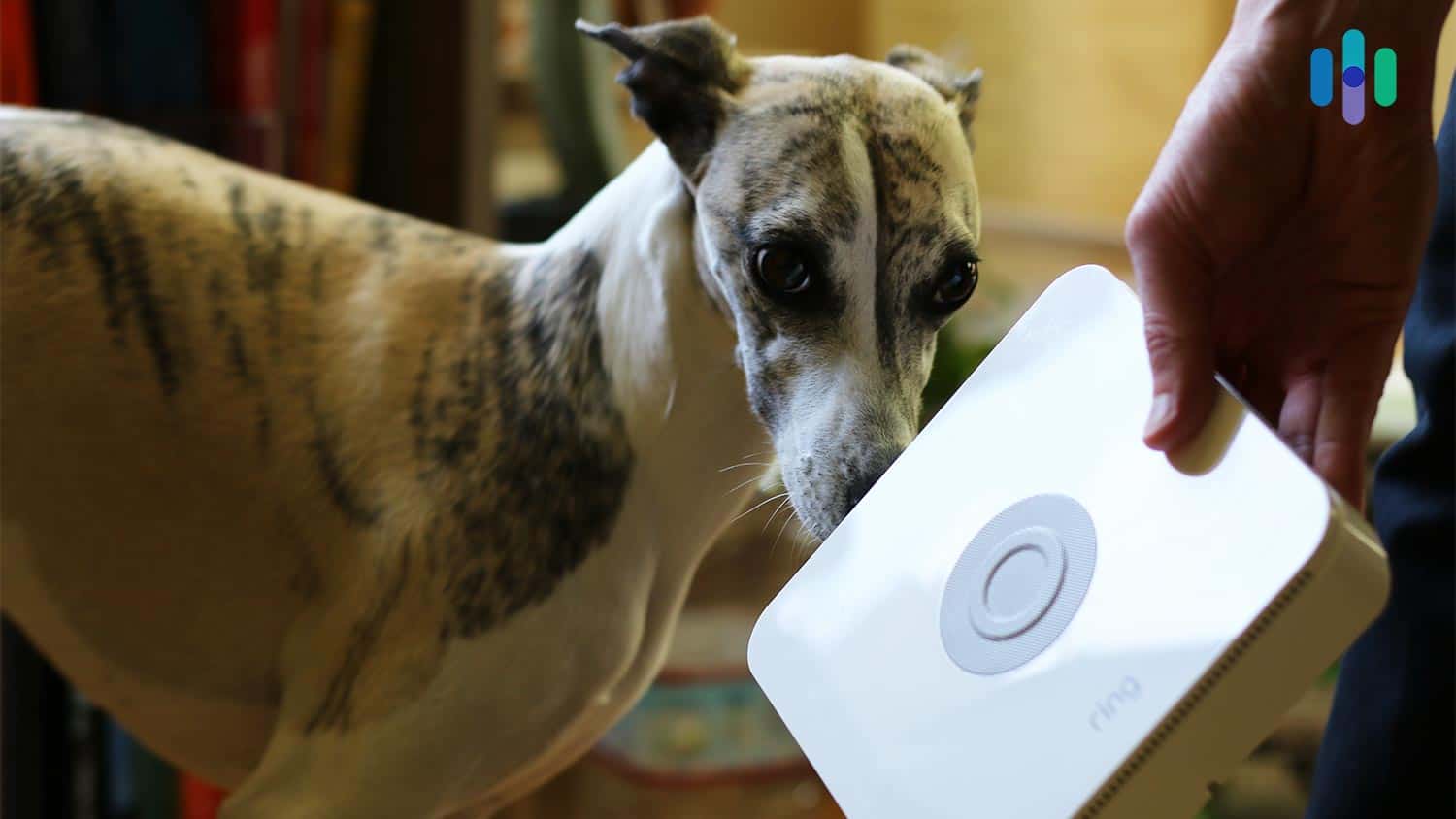
Wearing both our security expert and pet owner hats, we tested the top home security systems to find out which among them offer the best features for homes with pets. After testing over 60 security systems, we liked our ADT system the best. Its Google Nest Cams did the best job at preventing false alerts with their AI person detection features. Plus, the ADT motion sensor gave us the flexibility to ignore all motion from animals under 80 pounds.
Just because ADT was our favorite though doesn’t mean it’s the best system for you. So, we’re going to go over our top five picks to help you find the perfect system for your home. These were our top picks:
The 5 Best Security Systems for Homes with Pets
- ADT - Personalized Security System for Homes With Pets
- SimpliSafe - Security System With Improved Pet Safety Features
- Vivint - Smart Security System for Pet Safety and Comfort
- Cove - Affordable Pet-Friendly Security System
- Ring Alarm - Security System With App Features for Pet Owners
Overview of the Best Pet-Friendly Security Systems
| System |
ADT

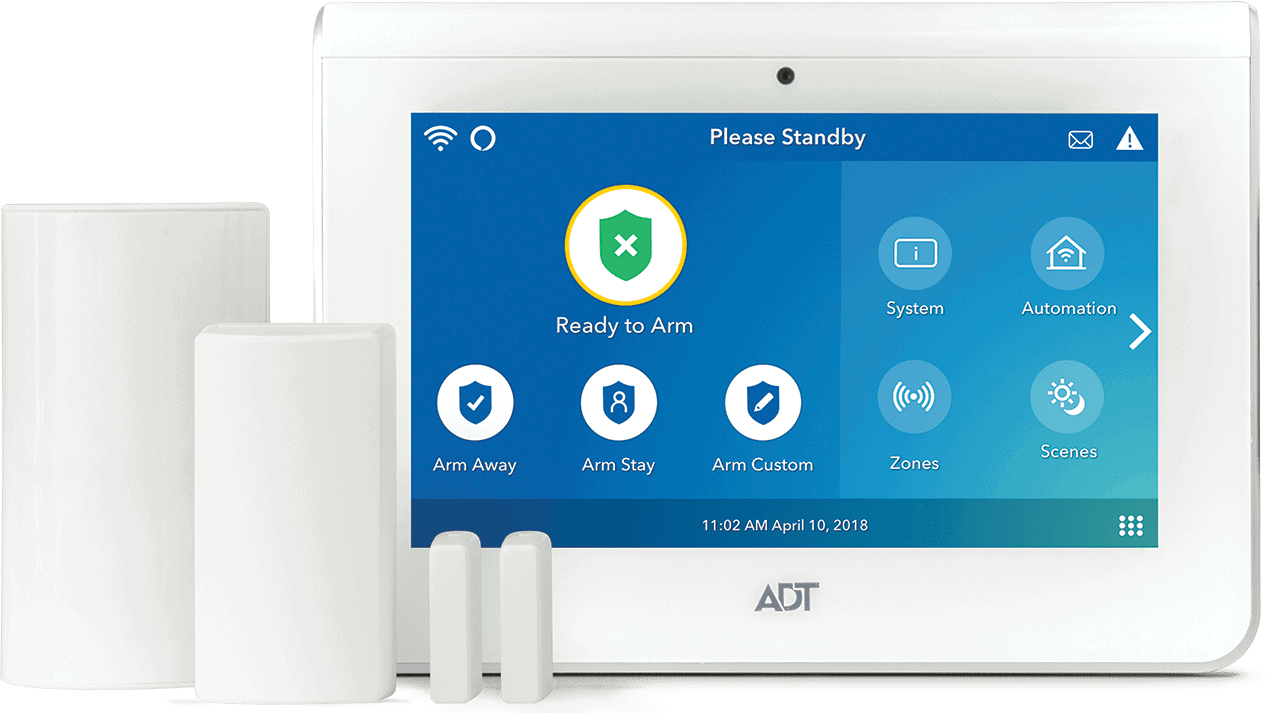
|
SimpliSafe

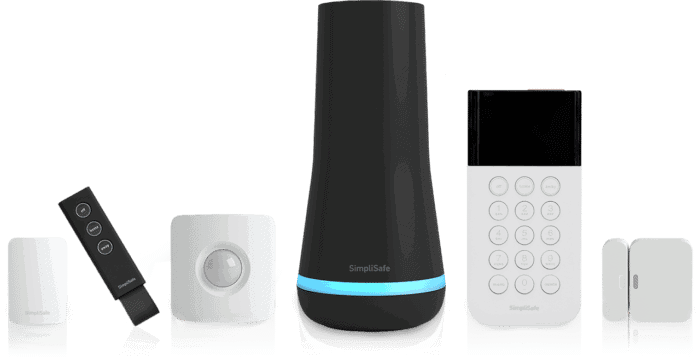
|
Vivint

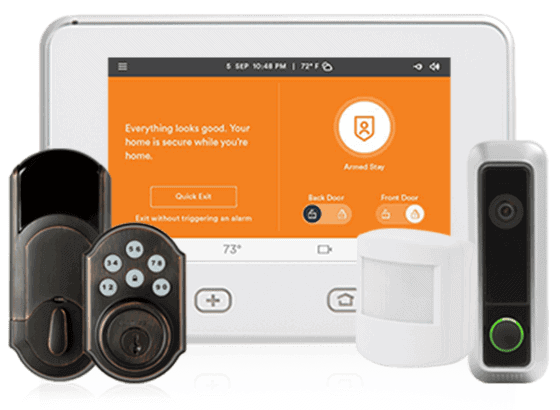
|
Cove

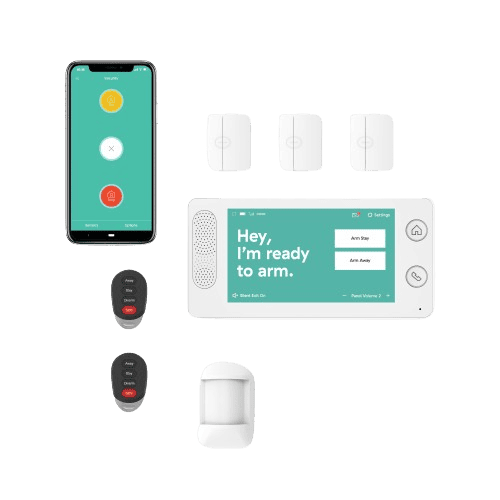
|
Ring Alarm

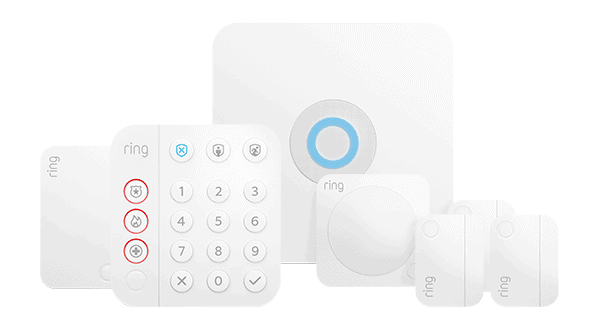
|
|---|---|---|---|---|---|
| Ranking | 1st | 2nd | 3rd | 4th | 5th |
| Ratings | 9.8/10 | 9.8/10 | 9.4/10 | 8.7/10 | 7.7/10 |
| Pet-friendly motion sensor | Tolerant of pets up to 80 lbs. | Tolerant of pets up to 60 lbs. | Tolerant of pets up to 55 lbs. | Tolerant of pets up to 55 lbs. | Tolerant of pets up to 50 lbs. |
| Pet detection in indoor camera | Yes, with human face detection | Yes | Yes | Yes | Yes |
| Safety sensors and devices | Smoke and gas leak detectors, smart thermostat | Temperature sensor, smoke and carbon monoxide detectors | Smoke and carbon monoxide detectors, smart thermostat | Smoke detector | Smoke and carbon monoxide alarm listener, pet ID tag with QR code |
| Monitoring type | Professional or DIY | Professional or DIY | Professional | DIY | Professional or DIY |
| Installation type | Professional | DIY | Professional | DIY | DIY |
| Read Review | ADT Review | SimpliSafe Review | Vivint Review | Cove Review | Ring Alarm Review |
Our Roundup of the Best Pet-Friendly Security Systems
-
1. ADT - Personalized Security System for Homes With Pets
Product Specs
Equipment Costs Packages starting at $269 Monitoring Options Professional and DIY Monthly Monitoring Costs Starting at $24.99 per month Contract Lengths Month-to-month or 36 months and up Installation Options Professional and DIY Smart Platform Integration Alexa and Google Home We like that an ADT technician installed our security system. Well, not so much the part where we had to pay over $100 for the service, but it was worth it because the technician was able to see our home’s layout and our pet in person. He figured out where to best place the motion sensors and cameras so that our hulking 65-pound Labrador wouldn’t trigger any false alarms. He also considered factors like the fact that our dog Max likes lounging on our sofa, so he made sure the sofa stayed out of the motion sensors’ peripherals.
Our ADT technician installed our Home Security Motion Detector near our entryway where our dog rarely roams. That was crucial, because ADT is a professionally monitored system. If Max triggers a false alarm and the police are called to our house, we’d have to pay a fine according to the alarm permit from our city. With ADT’s professional installation, our system was personalized for Max and for our home’s layout.
>> Learn More: How Much Is an ADT Security System?
What We Like
- Expert installation by a trained technician
- High-quality equipment including security and safety sensors
- Professional monitoring for break-ins and home hazards
- Security cameras with pet detection and facial recognition
What We Don’t Like
- $99 minimum charge for professional installation
- No silent arm feature (control panel beeps; can be annoying to pets)
- Equipment is more pricey than other options
- Three-year monitoring contract
Living with ADT as Pet Owners
As guardians of a gentle giant that weighs 65 pounds, we appreciate that the ADT motion sensor ignores pets up to 80 pounds. The motion sensors from ADT alternatives like SimpliSafe can only tolerate pets weighing up to 50 pounds. Upon testing our ADT system, we confirmed that Max doesn’t trigger the sensors.
We thought ADT’s professional monitoring style was pet-owner friendly as well due to a feature called SMART Monitoring. It lets ADT send us alerts via text instead of having to pick up a phone call. This lets us quickly dismiss alerts because Max knocked over another vase triggering our glass-break sensor.
>> More Information: Dealing with ADT False Alarms
Our ADT Smoke Detector was installed in our kitchen where a fire is most likely to break out. ADT can also keep your pets safe with its included fire and gas leak monitoring. They sent us an alert every time we burnt toast and set off the smoke alarm. Plus, ADT’s Trusted Neighbor feature ensures our neighbor can get in our home in the event of fire to get Max out of our house safely in case we’re not home.
The smoke alarms from ADT have a long battery life as well. That meant Max didn’t have to bark at the smoke alarm every three months due to those annoying smoke alarm chirps. Instead, it was once every two years which is a lot more tolerable.
FYI: Speaking of annoying sounds, we have to warn you that ADT doesn’t have a “silent arm” function on the keypad. It lets out a long beep whenever it’s armed. Max finds it intriguing, but your pets might react differently. Use the smartphone app to arm and disarm the system instead to avoid the sound.
Security Cameras
Would you use a $99 pet camera? Well, we wouldn’t either if it was just a simple camera, but ADT’s indoor camera is so much more than that. It’s the Google Nest Cam (indoor, wired), one of the best security cameras available. Feature-wise, it’s great for homes with pets. It can distinguish pets from humans, so it tells you whether a motion event was triggered by a person or an animal.
We mounted our Google Nest Cam on the side of our home overlooking our back yard so we could watch Max play outside. We also got to test the Nest Cam’s facial recognition. A sitter comes to our house on Mondays and Thursdays to walk Max, so we introduced him to the camera. We receive alerts whenever he arrives so we can give him instructions before taking Max out since ADT’s top-tier monitoring plan includes Nest Aware. That’s required for the Nest Cams advanced features like bark detection, facial recognition and cloud recording.
FYI: Read our full Nest Cam review for an in-depth look at everything these home security cameras can do for you and your pets.
-
2. SimpliSafe - Security System With Improved Pet Safety Features
Product Specs
Equipment Costs Packages starting at $250.96 Monitoring Options Professional and DIY Monthly Monitoring Costs Starts at $22.99 per month Contract Lengths Month-to-month Installation Options DIY or professional Smart Platform Integration Alexa and Google Home SimpliSafe is the polar opposite of ADT. It’s a DIY-installed security system that doesn’t require professional monitoring. You can self-monitor it if you’re worried about false alarms being sent to the police. We still recommend professional monitoring though. Just make sure to go with at least SimpliSafe’s Core monitoring plan. The Core plan and every plan above it includes video verification — in an emergency, the monitoring center will view your camera footage to see whether it’s a false alarm or a real intrusion.
We bought every device SimpliSafe offers for our comprehensive testing. Being a DIY system, we had to install SimpliSafe ourselves. It wasn’t a difficult process. However, the motion sensor’s high sensitivity had us scratching our heads. (More on that in a bit.)
What We Like
- Easy DIY setup with no special tools required
- Affordable professional monitoring
- Video verification for Fast Protect plan
- Temperature sensor for pets sensitive to extreme cold or heat
What We Don’t Like
- Motion sensors are too sensitive for homes with large pets
- Limited smart home equipment
- Limited features as a self-monitored alarm
- No free video storage for cameras
Living with SimpliSafe as Pet Owners
SimpliSafe’s motion sensor got us a little concerned. Based on our previous tests, we knew Max is too big for it to ignore since it’s only pet-friendly to animals less than 60 pounds. After digging around, we found a workaround. We installed the sensor upside down at a height slightly higher than our dog’s height when standing on his hind legs. That kept him out of sight from the sensor. Surprisingly, it worked and it still detected human movement – that is, as long as the person is standing up. Installing the sensor upside down limits its vertical detection range, and that’s why you should have other types of sensors as well, like door sensors and window sensors.
Our SimpliSafe Motion Sensor was small but mighty with a sleek design. Smoke alarms and carbon monoxide detectors are essential too, and SimpliSafe offers and monitors both. What we found unique is the SimpliSafe temperature sensor. It alerts us when temperatures hit a lower or upper threshold so we know when the house is getting uncomfortable for Max. Anytime that happens, we’d turn on our AC or heater through our ecobee Smart Thermostat to make sure Max remains comfy even when we aren’t home.
Unfortunately, home automation isn’t SimpliSafe’s strong suit, so we couldn’t automatically make our smart thermostat change when the temperature sensor reaches the upper threshold. That’s why we have to use a third-party thermostat.
Security Cameras
We installed our SimpliSafe Outdoor Camera next to our garage so we could check when the dog walker took our dog out. We liked using the Wireless Indoor Cam in our pet-friendly home. It uses a passive infrared (PIR) sensor to detect movement, so it’s not prone to false alarms. It also uses PIR to ignore pets.
Our favorite capability though is how it works when paired with SimpliSafe’s Intruder Intervention feature that comes with their Core, Pro, and Pro Plus monitoring plans. When our system triggers an alarm, SimpliSafe’s monitoring agents can connect through our Wireless Indoor Cam to see what’s going on in our home through the camera’s lens. Doing so lets them immediately find out if it’s a false alarm set off by our dog or a real intruder. In case it’s the latter, they can intervene using the same camera’s two-way audio.
>> Check Out: The Best Pet-Friendly Security Cameras
-
3. Vivint - Smart Security System for Pet Safety and Comfort
Product Specs
Equipment costs Starting at $599 Monitoring options Professional Monthly monitoring costs Starting from $30 per month Contract lengths Starting at 42 months Installation options Professional Smart platform integration Alexa and Google Home Vivint is a lot like ADT, since it requires professional monitoring and installation. We found it to be a better option for pet owners who want to use smart home features to keep their pets safe and comfortable. That’s thanks largely to Vivint’s strong smart home capabilities. It’s arguably the best smart home security system if we’re strictly talking about features.
Our Vivint Base Hub was a touch screen that could control our entire system and all of our smart home devices. For example, when we got Vivint installed, we asked the technician to set it so that the Vivint smart thermostat sets the temperature between 75 and 80 degrees as soon as we leave the house. This automated rule kept Max warm and toasty last winter.
What We Like
- Automated scenes and routines
- High-quality smart cameras
- Reliable professional monitoring
- Expert installation
What We Don’t Like
- Requires a contract (up to five years)
- Expensive equipment
- Lowest sensitivity setting might be too low
- Doesn’t work without professional monitoring
Living with Vivint as Pet Owners
A technician installed our Vivint motion sensor and recommended setting the “PET” setting to “25K” (which ignores pets up to 55 pounds) and the sensitivity setting (SENS) to “LOW.” We were concerned it might fail to catch real break-ins, though, since the technician placed it at the end of our hallway. So after he left, we set the sensitivity to “HIGH.” It worked for us; Max still didn’t trigger the sensor, and we felt more confident that it would catch a thief.
Vivint’s home automation features also kept our Max safe and comfy at home. There are too many features to mention here, so we’ll give you a couple of examples we tried.
The Vivint mobile app let us control our entire system and our thermostat. First, we created automated scenes that activate at the touch of a button on the digital panel. We created a “Leaving” scene, where the system arms, the door locks after a short delay, the smart lights near Max’s crate turn on, and the Vivint thermostat sets the temperature to 78 degrees.
Second, Vivint can autonomously trigger actions when a certain event occurs. We set the Vivint thermostat to shut off the air vents immediately as soon as the smoke alarm detects smoke. That way, it would slow down the spread of fire if there was ever one.
With those automations, Vivint goes above and beyond what most security systems offer. It even edges out ADT in that regard.
>> Compare: Vivint vs. ADT
Security Cameras
We mounted our Vivint Outdoor Camera Pro (Gen 2) so its active deterrence feature could clearly be seen by passersby. Vivint’s security cameras also excel, but if you thought SimpliSafe’s $99 indoor camera was expensive, you might not like Vivint’s pricing. The Vivint Indoor Camera Pro costs a staggering $249. Of course, you’ll get top-of-the-line features at that price point. We’re talking about person and pet detection powered by AI, clear video with HDR that provides good lighting balance, two-way audio, and more.
The Vivint indoor security camera also works without Wi-Fi. It can record important footage onto its microSD card, although livestreaming and two-way talk obviously won’t work. It’s expensive as a pet camera, but we think it’s a really good high-end security camera.
-
4. Cove - Affordable Pet-Friendly Security System
See Pricing Links to Covesmart.comProduct Specs
Equipment Costs Systems start at $86.25 Monitoring Options Professional only Monthly Monitoring Costs Starting at $19.99 per month Contract Lengths Month-to-month Installation Options Professional or DIY Smart Platform Integration Alexa and Google Home After talking about the high-end Vivint system, we thought we could use a palate cleanser. Cue Cove. From a features standpoint, it’s the least impressive pet-friendly system we tested. However, it’s also the most affordable. It’s a practical option for pet owners who want a security system that won’t cause any unnecessary ruckus over pets having the zoomies.
We bought a complete Cove Security System including security systems so we could test it in our home. Cove is a DIY system just like SimpliSafe, but it’s more affordable. Note that Cove’s pricing for monitoring is $19.99 to $29.99 per month, and the equipment cost is offset by its frequent deals. We got our Cove system for 50 percent off, and since it is DIY, we didn’t have to pay an installation fee.
What We Like
- Affordable equipment and frequent discounts
- Monitoring for less than $30 per month
- Contract-free
- Offers affordable security cameras
What We Don’t Like
- Pet-immune up to 50 pounds only
- Doesn’t work as a self-monitored system, unlike SimpliSafe
- Limited equipment options
- No gas leak detector
Living with Cove as Pet Owners
Cove’s motion sensor is just like the one from SimpliSafe. It isn’t pet-immune enough for Max, but you should be fine if your pet weighs less than 55 pounds. For Max, though, we had to mount the sensor upside down like we did with SimpliSafe.
We did find a blog from Cove saying that the motion sensor is “AI enhanced” because it picks up heat signatures, but for clarity, that’s how all motion sensors work.
With its symmetrical design, our Cove Motion Detector didn’t look out of place when we mounted it upside down. Cove had us covered against fire, carbon monoxide, and water leaks too. Their monitoring includes environmental protection even in their lower tier for about $20 per month, which we appreciate. Although, we wish there were more home automation features. As it stands, Cove offers the same if not less home automation features than SimpliSafe.
Pro Tip: Cove’s top-tier monitoring plan comes with a $5 per month equipment voucher. Whether it’s because you’re on a budget or you want to see which components work best in your home, Cove makes it easy and affordable to build a security system over time.
>> More Options: The Best Affordable Security Systems
Security Cameras
Cove offers security cameras from eufy. We put our eufy 2K Camera on our desk. In fairness, though, Cove offers security cameras. And like ADT, Cove gets its cameras from a reputable security camera brand. Cove’s indoor camera is a wireless 2K security camera from eufy. Here’s our eufy 2K review; it’s not the exact same model, but it shares a lot of the same attributes.
The eufy indoor camera from Cove offers good value, in our opinion. It costs $59.99 — the cheapest option so far — and offers a 2K resolution, which is higher than even the Nest Cam, SimpliCam, and Vivint Indoor Camera. Its pet detection wasn’t as consistent, though, but thanks to activity zones, we were able to exclude the parts of our living room where Max often hangs out from the detection range.
-
5. Ring Alarm - Security System With App Features for Pet Owners
View on Amazon Links to Amazon.comProduct Specs
Equipment Costs Packages starting at $199.99 Monitoring Options Professional and DIY Monthly Monitoring Costs $20 per month with Ring Home Plus Contract Lengths 1-12 months Installation Options DIY or professional Smart Platform Integration Alexa and Google Home Ring is the oddball of this group. While it does offer a reliable security system called the Ring Alarm, its main offering consists of security cameras and video doorbells. In fact, it has a lineup of eight different video doorbells and over a dozen different types of security cameras. All Ring devices work together and can be monitored via the Ring app.
Our Ring Alarm system required a keypad and base station for our entry sensors and motion sensor. We’d like to call out the Ring app specifically because it’s thoughtfully designed for pet owners. For example, motion alerts from our indoor camera came in the form of detailed notifications. Instead of just texts, they include a snapshot of what triggered the event so we can see if it’s a false alarm or a real cause for concern.
>> Learn More: Ring Security Camera Lineup and Pricing
What We Like
- Huge lineup of security and doorbell cameras
- Affordable cloud storage ($10 monthly for unlimited cameras)
- Easy DIY setup
- Intuitively designed home security app
What We Don’t Like
- No smoke alarms (but works with third-party smoke alarms)
- Limited home security equipment
- Cameras don’t have free local or cloud storage
- Motion sensors aren’t suited for large pets or homes with multiple pets
Living with Ring as Pet Owners
Ring’s PIR motion sensor is pet-friendly to some degree, and unlike other pet sensors we tested, the sensitivity is controlled via the Ring app. The default setting is immune to pets less than 15 pounds. The medium setting is for pets up to 30 pounds. The lowest setting ignores pets up to 50 pounds. Unfortunately, it wasn’t immune to Max at all, so think twice about getting a Ring Alarm if you have larger pets.
Our Ring Alarm Motion Sensor (2nd Gen) picked up our large dog every time he walked by. Ring also doesn’t offer smoke alarms, but the system pairs seamlessly with smoke alarms from First Alert. They offer a smoke and CO listener which triggers your Ring Alarm system when your regular smoke alarm starts beeping. Ring also includes fire monitoring in its professional monitoring plans. That includes their Flood and Freeze Alarm too, which alerts users to extremely low temperatures indoors.
Our favorite safety feature, however, is the $9.99 pet tag engraved with a personalized QR code. It’s not a GPS tracker, but if your pet ever gets out of the house, whoever finds it can scan the QR code to see your pet’s profile and information (medical conditions, name, etc.). For your privacy, your contact details and home address aren’t included in the information, but scanning the QR code will give someone the option to call or text you anonymously. It may seem like a minor feature, but we love Ring’s thoughtfulness here.
>> Related: The Best Security Systems With Apps
Security Cameras
Ring’s indoor camera, the Ring Indoor Cam, is just as affordable as the eufy camera from Cove, yet it offers slightly more advanced features. There’s a catch, though: You’ll need to sign up for a Ring Home plan to enjoy those features. Ring’s pricing for their advanced camera features starts at $4.99 per month for one camera or $9.99 per month for unlimited cameras. Professional monitoring adds $10 per month to any cloud storage plan that supports unlimited cameras. That’s pretty affordable.
We tested the Ring Indoor Cam (2nd Gen) and put it on our bookshelf in the corner of our living room. So what features did we get? First, we got pre-roll videos. By buffering live videos, the Ring Indoor Cam was able to start its recordings seconds before the motion event that triggered it. Second, we got person and pet detection. Third, we were able to set our Indoor Cam to trigger other Ring cameras to record. All those features translated to all-around video security, which is one of our favorite things about Ring.
How to Choose From Our Top Pet-Friendly Systems
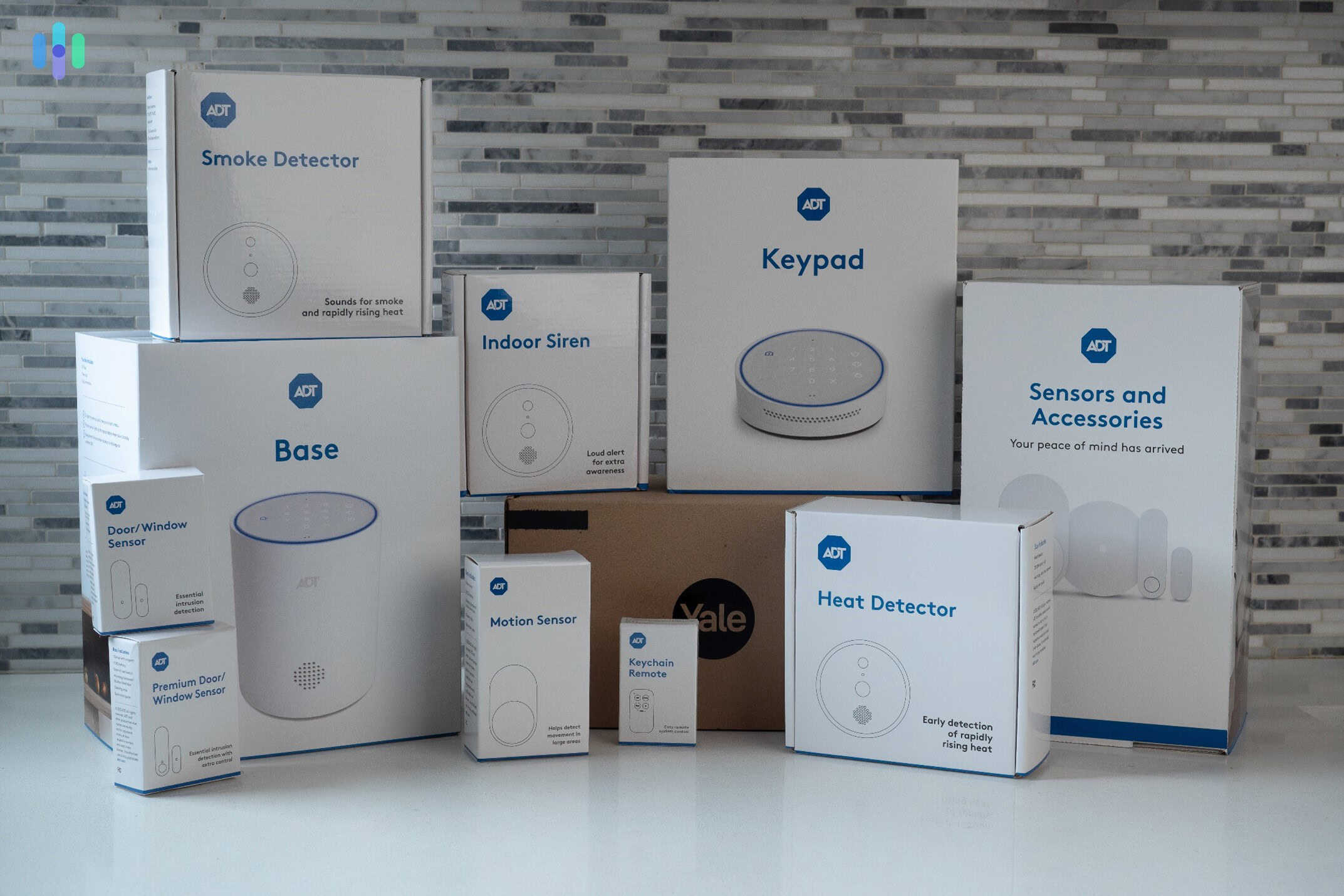
When choosing a pet-friendly security system, keep in mind that you’re buying a security system for your home’s protection, not only for your pet’s.
Start by identifying your biggest security concerns — for example, an easily accessible second-floor window, a large front yard with potential hiding spots, an unsecured tool shed, etc. By doing so, you’ll be able to decide what type of equipment to look for.
Once you have a list of equipment, decide whether you want professional or DIY installation. Both work, but be prepared for the installation fee if you’re going with a professional, or be ready to do the work if you opt for DIY. If you need more options, feel free to check our list of the best professionally installed systems or our roundup of the top DIY security systems.
Similarly, choose your monitoring style. Almost all security systems offer professional monitoring, but for those who want to self-monitor, take a look at our favorite self-monitored security systems.
Factors to Consider Related to Your Pets
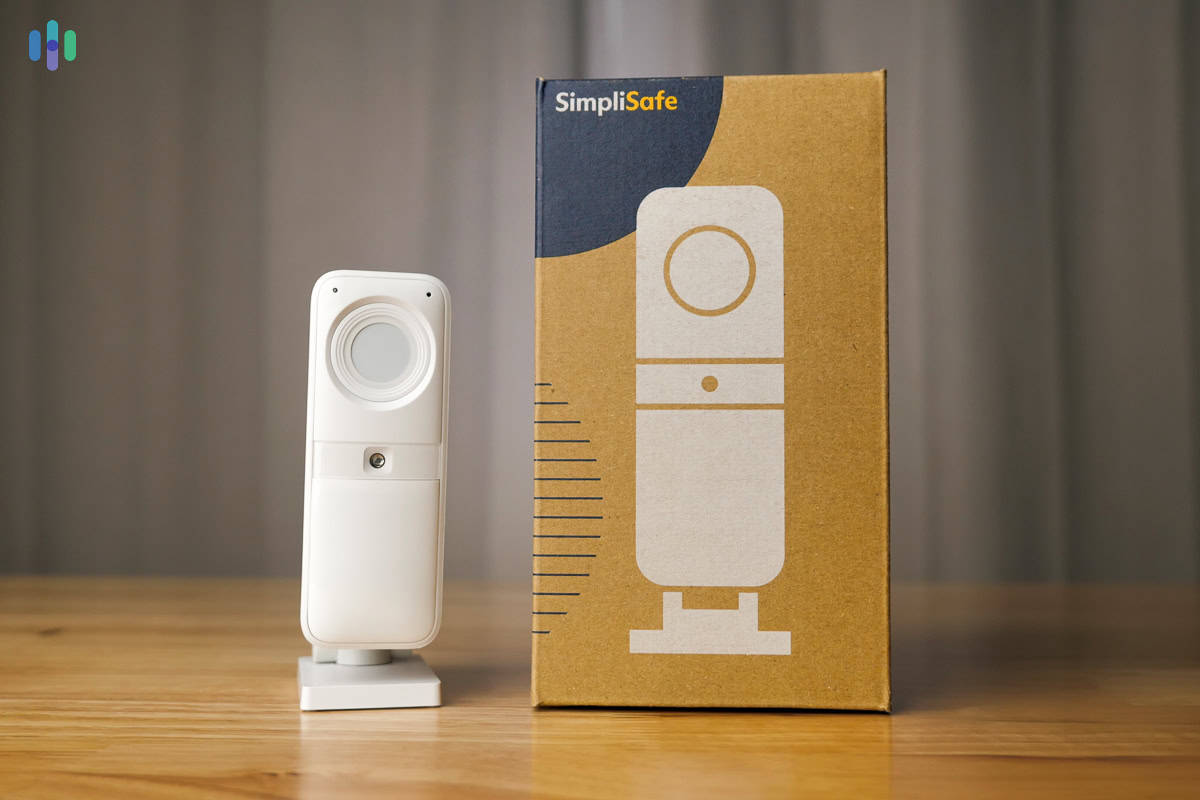
Not all security systems are pet-friendly, so once you have your top picks, it’s time to filter through them by entering your pet into the equation. Here are some factors to consider:
- Size and activity level: Most pet-friendly security systems won’t have a problem ignoring small dogs and cats. It’s the larger and/or more active pets that give them trouble, so check if your alarm company has equipment suited for large or active pets.
- Pets that climb furniture: Most felines may be small enough to stay under the radar of pet-friendly motion sensors, but they can still trigger false alarms if they like climbing furniture. If that can’t be avoided, it might be better to skip the motion sensor altogether and opt for other types of sensors, like entry or glass-break sensors.
- Crated vs. non-crated: Setting up a security system is easier if your pets remain in a crate while you’re away. That way, you can simply avoid putting up sensors around their crate. If they’re not used to staying in a crate, though, you might have to make adjustments, such as closing off certain areas with a pet gate.
- Security camera two-way talk: The top indoor cameras today offer two-way talk, but observe how your pet responds before using this feature. Some respond positively to hearing their owner’s voice through a camera, but it can also trigger separation anxiety in other pets.
- If you have a doggy door: If your pets can freely exit the house through a doggy door, it may be smart to monitor it. A simple door sensor can let you know their comings and goings, but you should also consider putting up an outdoor camera. That way, in case they don’t come back, you’ll have a lead on where they went.
Choosing a security system that can work for you and your four-legged companion isn’t always easy. You may have to make compromises along the way. What’s important is that there are security systems out there that can keep your pets safe while also keeping criminals out.
Pet Safety Tips
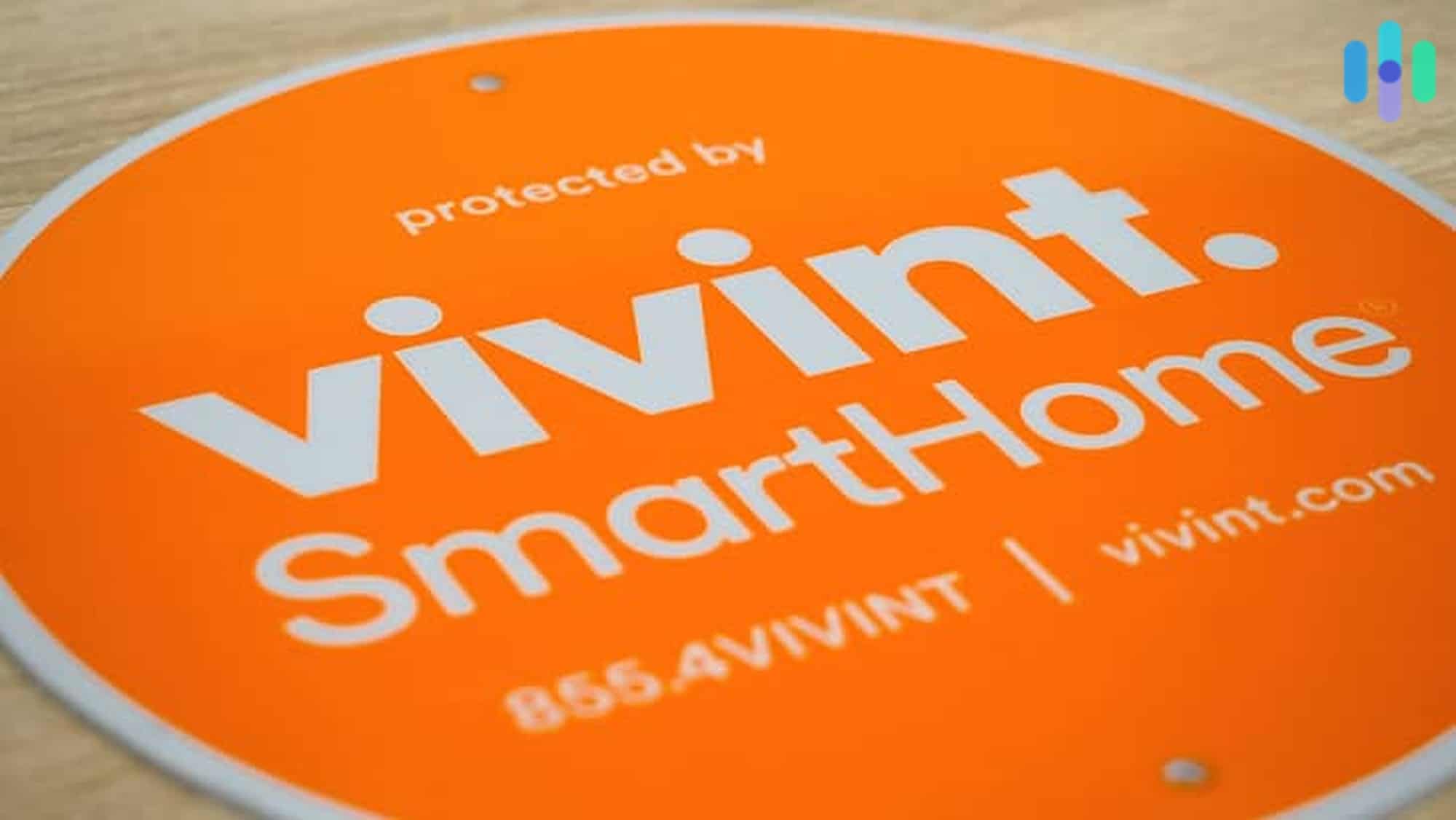
Let’s face it, keeping our pets safe isn’t always easy. Whether it’s a dog that tries to bolt out of the door every time it opens or a cat constantly trying to get into food it shouldn’t eat in the pantry, owning a pet is a lot of responsibility. We’re definitely not animal training experts, but as home security experts, we can recommend a few safety tips in that regard.
- Use a pet tracking device: Pets can escape from our homes no matter how careful we are. And when that happens, tracking them down feels like finding a needle in a haystack. But with a pet tracking device, you can find them as soon as you realize they escaped.
- Keep smoke detectors active: A smoke detector can save the lives of pets. In the case of a fire, smoke detectors notify you immediately giving you enough time to save your pet. Always replace the batteries on your smoke detector when they get low. Don’t just ignore your smoke alarm’s chirping.
- Use carbon monoxide detectors: You can’t see or smell carbon monoxide and pets can get sick from carbon monoxide poisoning too. Oftentimes, at lower concentrations than people since they’re smaller. If you don’t already have one, install a carbon monoxide detector today.
- Install a home security system: Burglars and home invaders usually don’t have much sympathy for pets. They see them as a barrier to their goal. A home security system helps deter burglars from attempting to rob your home in the first place.
Do I Need a Security System If I Already Have a Dog?
Most home security experts agree that owning a dog makes your home safer. Just the bark can scare off criminals. They know if they try to break in, there’s an unknown threat on the other side of that window or door. But, is it enough?
We don’t think so. For one, if a break-in does happen, a dog can’t record evidence. You’ll need that evidence for your police report if you want hope of catching the perpetrator and potentially recovering your stolen goods.
On top of evidence, home security systems can get emergency personnel to your house faster than you can in most circumstances. That gives you a better chance of police arriving in time to catch the perpetrator. Or, in the event of a fire or other environmental hazard, monitoring gets first responders on the scene before the situation escalates.
Lastly, consider your pet’s safety too. If an armed and determined intruder breaks in, there’s no telling what they would do to get what they want.
Methodology: Choosing a Security System for Pet Owners
How We Review Our Top Home Security Systems for Pet Owners
From a pool of about 60 security systems, our experts found the systems with the best features for households with pets. We then installed them in our homes and tested them for months. Primarily, we’re looking for quality equipment and top monitoring services on a budget. But we also look for features that pet owners need, like customizable sensors and zones, and cameras with two-way audio that can also serve as pet cams.
How We Rank the Best Security Systems for Pet Owners
The main hurdle when choosing a pet-friendly security system is making sure our pets can coexist with it. To that end, we researched the major requirements for pet owners in the market for a home security system, then ranked our top security systems according to how well they satisfied them.
- Motion sensors and glass-break sensors with pet settings (40%): Pets can accidentally trigger sensitive sensors, so pet-friendly sensors that know how to ignore cats and dogs are a must. Our top picks have sensors you can calibrate to avoid non-stop alerts from frisky companions as well as quality security cameras that can double as pet cams.
- Programmable zones and other pet features (30%): If there are places where your pet spends a lot of time, like the couch, and you don’t want to be notified every time they get up, you can program our favorite security cameras for pets to bypass high-traffic pet zones. Some of our top choices even have features that can help you locate a lost cat or dog.
- Overall reliability. Your goal isn’t just to buy a pet-friendly system, though. You want a high-quality security system that also works in a home with pets. That’s why all our top picks are also the best security systems overall, offering a range of options — from DIY to professionally installed and monitored systems.
>> Learn More: DIY vs. Professional Installation
The Security.Org Team
We’re a team of security professionals who research and write about all things home and digital security. Together, we’ve written over 1,000 articles and studies, a number of which have been cited in top publications like HuffPost, The New York Times, The Washington Post, and Tech Radar.
- Gene Petrino is a former SWAT Commander and home security expert.
- Corey Birnstengel is a top home security and cybersecurity influencer. He’s installed and reviewed over 200 security cameras.
- Brett Cruz is our resident digital safety expert. He leads our security team in all things VPN and Antivirus.
- Paul Frew is an expert in home security and family safety. He tests and reviews security cameras, doorbell cameras, and home security systems.
- Cort Honey is an engineer with a focus on digital security. He heads our Identity Theft and Data Removal software unit.
Our team milestones:
- 600+ written product reviews and counting
- 450+ video reviews on our YouTube channel
- 100+ research and studies
- 50+ guides on home, personal, and digital safety topics
Recap
We saw how different security systems adapt to our needs as pet owners, from thoughtfully designed apps to home automation features that improve comfort and safety to security cameras that can keep our pets from missing us. Ultimately, the best choice depends on your priorities and your specific needs.
Here’s a recap of the best home security systems for pet owners:
- ADT stands out with its personalized installation and professional monitoring. It’s an ideal option for those looking for a comprehensive security solution.
- SimpliSafe is an affordable DIY option with improved pet safety features, and we particularly like the temperature sensor that can alert you if your home gets too warm or cold.
- Vivint is a smart home security system that incorporates home automation to improve the safety and comfort of everyone living in your house, including pets.
- Cove is an affordable pet-friendly alternative that may not offer flashy features but can perfectly coexist with your pets.
- Ring Alarm is a robust security system that features high quality security cameras and an intuitive app designed with pets and pet owners in mind.
Which one is best for you? Take your pick.
FAQs About Pet Friendly Security Systems
-
Are all motion sensors pet-immune?
Not all motion sensors are pet-immune. However, at the very least, most motion sensors will ignore pets less than 20 pounds. If you have a larger pet or a cat with the propensity for climbing furniture, you must look for motion sensors that are specifically described as pet-immune or pet-friendly.
-
Can I communicate with my pets while I'm away using my security system?
You can communicate and check on your pets remotely using any security system as long as it has the right components and features. You’ll need an indoor camera with two-way audio, a mobile app that can stream video from the camera in real-time, and a strong Wi-Fi or cellular connection.
-
Can barking dogs set off glass break sensors?
Glass break sensors are triggered by loud noises that register at similar decibels and pitches as the sound of glass breaking, so it is possible for a dog’s bark to set off glass break sensors. To avoid false alarms, we suggest placing glass break sensors in rooms inaccessible to pets or adjusting their sensitivity.
-
Can pets trigger motion-activated security cameras?
Whether your camera uses PIR motion sensors or computer vision to detect movement, pets can trigger motion-activated cameras. However, there are features like person detection, facial recognition, and activity zones that can reduce the chances of false alarms.
-
How do I keep my pet safe?
Keep your pets safe by keeping their environment safe. Our furry friends are more vulnerable to toxic gas, extreme temperatures, and fire than we are. That’s why installing environmental sensors is a must. Carbon monoxide detectors, smoke alarms, and even flood and freeze sensors can warn you if there’s a dangerous situation at home.


